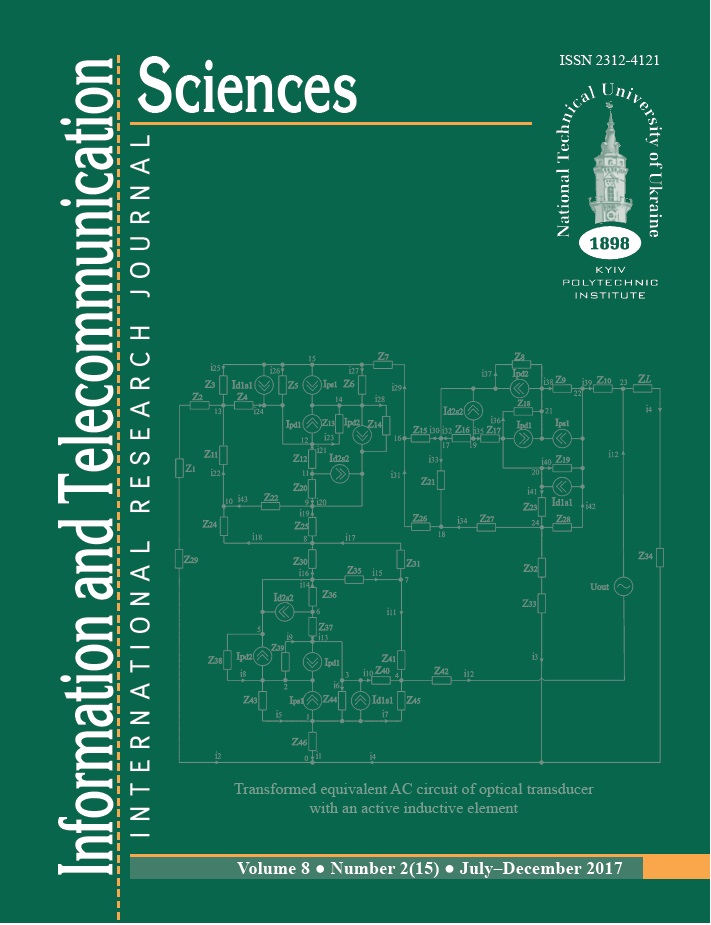DEPENDENCE APPROXIMATION OF THE HURST COEFFICIENT ON THE TRAFFIC DISTRIBUTION PARAMETER
DOI:
https://doi.org/10.20535/2411-2976.22017.18-22Keywords:
quality of service, Hurst coefficient, self-similar traffic.Abstract
Background. Despite the popularity of the model of self-similar traffic, until now a number of tasks of assessing the quality of service in the packet communication network remains unresolved. Because of the lack of a rigorous theoretical base that can complement the classical queuing theory when designing a packet-based communication network with self-similar traffic, there is no reliable and recognized methodology for calculating parameters and quality indicators for information distribution systems under conditions of the self-similarity effect.
Objective. The aim of the paper is the improvement of the accuracy of calculating the quality of service characteristics by obtaining a new formula for calculating the traffic self-similarity coefficient, depending on the parameter of the form of the Weibull or Pareto distributions. Self-similar traffic or the time interval between stream packets is described by these distributions.
Methods. To calculate the QoS characteristics, you only need to know the parameter a of the Weibull or Pareto distribution form and there is no need to calculate in a rather complicated way, for example, the R/S-method, the self-similarity coefficient of Hurst for traffic.
Results. A significant difference between the real and the linear dependence of the self-similarity coefficient H on the parameter a of the Weibull distribution form or on the parameter a of the Pareto distribution form is detected.
Conclusions. The use of real functional dependences of H on a allows enhancing the accuracy of calculating the quality of service characteristics.
Keywords: quality of service: Hurst coefficient: self-similar traffic.
References
Lozhkovskyi A.G. Comparative analysis of methods for calculating
quality of service characteristics for self-similar flows in a network /
A.G. Lozhkovskyi // Modeling and Information Technology: Collection
of scientific works of the IPME them. G. E. Puhov NAS of Ukraine. –
К., 2008. – No. 47. – P. 187-193. [in Russian].
Lozhkovskyi A.G. Mathematical model of packet traffic. / A.G.
Lozhkovskyi, O.V. Verbanov, V.A. Kaptur, V.M. Kolchar // Bulletin
of the National Polytechnic University "KhPI". - 2011. - No. 9. - P.
-119. [in Russian].
Norros Ilkka. A storage model with self-similar input. – Queuing
Systems, 1994. – Vol. 1.
Krylov V.V. The theory of teletraffic and its applications. / V.V.
Krylov, S.S. Samokhvalova - SPb .: BHV-Petersburg. - 2005 - 288 pp .: il. [in Russian].
Mandelbrot B. The Fractal Geometry of Nature // Computing in
mathematics, physics, biolog; translate from engl. B. Mandelbrot – M.:
Institute of Computer Scienc, - 2002. [in Russian].
Lozhkovskyi A.G. Modeling a multi-channel service system with
queue organization / A.G. Lozhkovskyi, N.S. Salmsnov, O.V. Verbanov // Eastern European Journal of Advanced Technology. – 2007. – № 3/6 (27). – P. 72-76. [in Russian].

